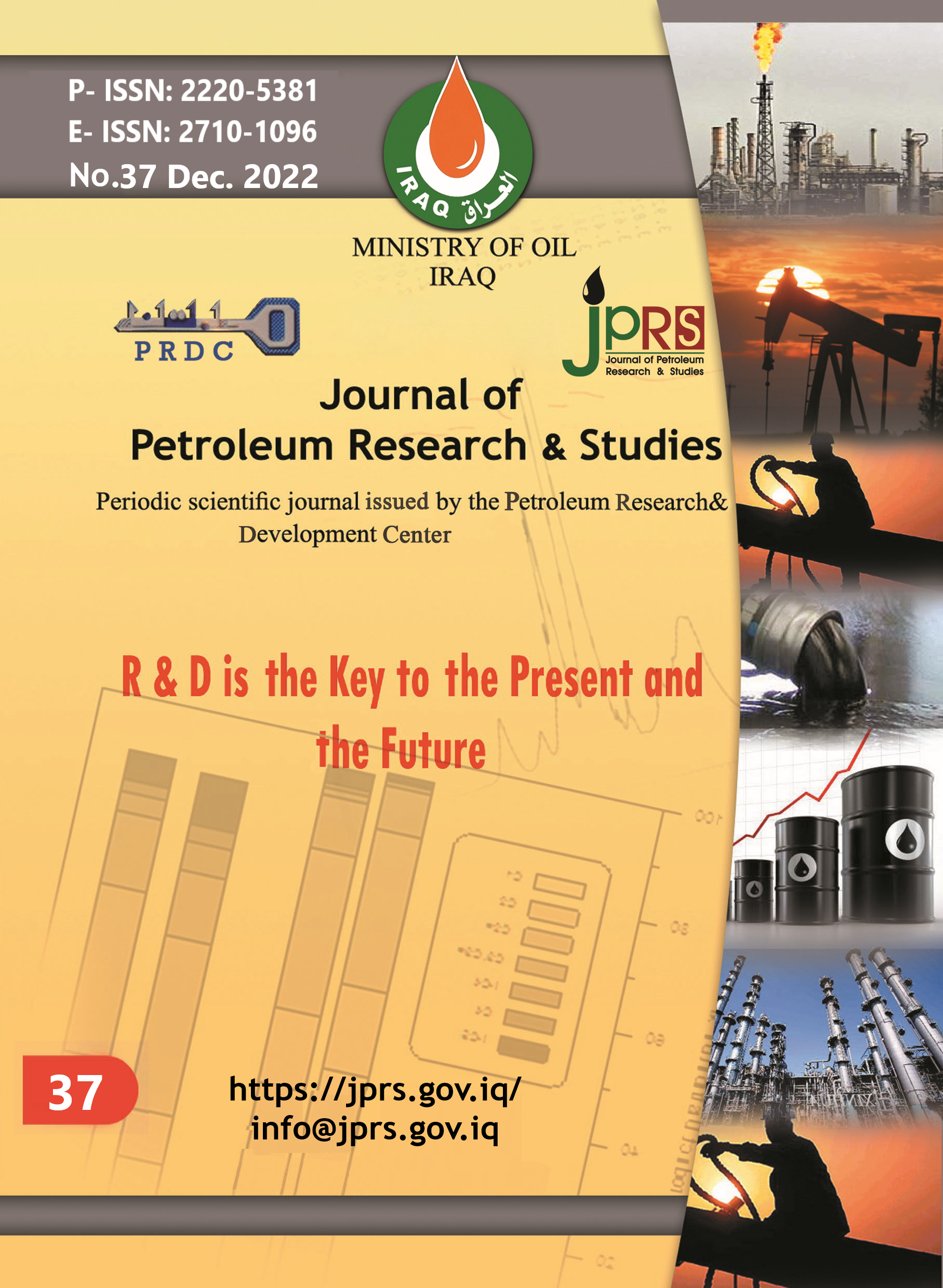Furfural Removal from Refinery Wastewater by Adsorption on Commercial Activated Carbon
DOI:
https://doi.org/10.52716/jprs.v12i4.726Keywords:
Furfural; activated carbon; waste water; adsorption; batch method.Abstract
Furfural is a toxic aromatic aldehyde that can cause severe environmental problems, especially the wastewater discharge from petroleum refinery units. The effect of adsorption variables, which include time (30-240) min, initial concentration of furfural (40-5080) mg/l, and amount of adsorbent material (10, 15, and 20 g\250 ml). The commercial activated carbon was investigated in a batch process in order to obtain the maximum furfural removal from wastewater. The results obtained from the experimental investigations showed that furfural removal increases with the increasing adsorbent material and decreases with increasing furfural concentration. Best Furfural removal efficiency was obtained at pH value equal 7.0, agitation speed 150 rpm, contact time 240 minutes. Chemical adsorption takes place when increasing temperature adsorption capacity increases. The best solvent used to regenerate activated carbon was ethanol 50 wt%. Ethanol has been used in industrial applications due to its low cost and relatively eco-friendly solvent. The laboratory experiments were done, and the sump drum O3D4, D-303 site was chosen to execute the project. The maximum contamination in the furfural was 100 ppm. The dimension of the polluted area in the sump drum (O3D4, D-303) was 20.3, 45 m2. The amount of activated carbon used 327, 726.3 kg.
References
Z. Hu, M. P. Srinivasan, and Y. Ni, “Novel activation process for preparing highly microporous and mesoporous activated carbons Novel activation process for preparing highly microporous and mesoporous activated carbons” vol. 39, no. July 2015, pp. 877–886, 2001.
S. Hazourli, M. Ziati, and A. Hazourli, “Characterization of activated carbon prepared from lignocellulosic natural residue:-Example of date stones-” Phys. Procedia, vol. 2, no. 3, pp. 1039–1043, 2009.
T. Golash-Boza and P. Hondagneu-Sotelo, “Latino immigrant men and the deportation crisis: A gendered racial removal program” Lat. Stud., vol. 11, no. 3, pp. 271–292, 2013.
G. Naja and B. Volesky, “Multi-metal biosorption in a fixed-bed flowthrough column,” Colloids Surfaces A Physicochem. Eng. Asp., vol. 281, no. 1–3, pp. 194–201, 2006.
J. Gravitis, N. Vedernikov, J. Zandersons, and A. Kokorevics, “Furfural and levoglucosan production from deciduous wood and agricultural wastes,” Chem. Mater. from Renew. Resour., pp. 110–122, 2001.
K. S. Rao, S. Anand, and P. Venkateswarlu, “Modeling the kinetics of Cd(II) adsorption on Syzygium cumini L leaf powder in a fixed bed mini column,” J. Ind. Eng. Chem., vol. 17, no. 2, pp. 174–181, 2011.
Y. S. Al-Degs, M. I. El-Barghouthi, A. H. El-Sheikh, and G. M. Walker, “Effect of solution pH, ionic strength, and temperature on adsorption behavior of reactive dyes on activated carbon”, Dye. Pigment., vol. 77, no. 1, pp. 16–23, 2008.
Z. Aksu and F. Gönen, “Biosorption of phenol by immobilized activated sludge in a continuous packed bed: Prediction of breakthrough curves”, Process Biochem., vol. 39, no. 5, pp. 599–613, 2004.
E. Malkoç, Y. Nuhoğlu, and M. Dundar, “Adsorption of chromium (VI) on pomace - An olive oil industry waste: Batch and column studies”, Journal of Hazardous Materials, vol. 138, no. B138, pp. 142– 151, 2006.
J. Goel, K. Kadirvelu, C. Rajagopal, and V. K. Garg, “Removal of lead(II) by adsorption using treated granular activated carbon: Batch and column studies”, Journal of Hazardous Materials, vol. 125, no. 1–3, pp. 211–220, 2005.
A. A. Amina, A. M. M. Reham, S. A. Kheder, G. M. Mohmed, and E. S. E. Shaymaa, “The effect of activation method on the adsorption performance of saw-dust activation carbon”, Res. J. Chem. Environ., vol. 19, no. 4, pp. 15– 28, 2015.
A. S. Abbas, M. J. Ahmed, and T. M. Darweesh, “Adsorption of Fluoroquinolones Antibiotics on Activated Carbon by K2CO3 with Microwave Assisted Activation”, vol. 17, no.2, pp. 15–23, 2016.
Downloads
Published
How to Cite
Issue
Section
License
Copyright (c) 2022 Rouaa N. Ghazy, Ibtehal K. Shakir

This work is licensed under a Creative Commons Attribution 4.0 International License.














